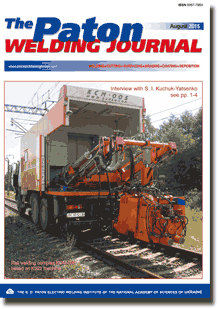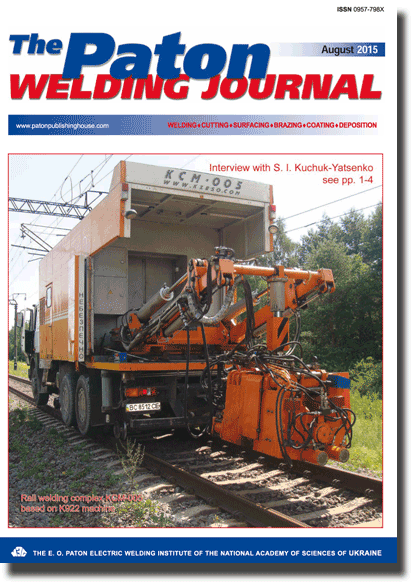| 2015 №08 (01) |
DOI of Article 10.15407/tpwj2015.08.02 |
2015 №08 (03) |

The Paton Welding Journal, 2015, #8, 8-13 pages
Influence of thermodynamic and structural parameters of multilayer foils on SHS process characteristics
M.V. Kravchuk And A.I. Ustinov
E.O. Paton Electric Welding Institute, NASU. 11 Bozhenko Str., 03680, Kiev, Ukraine. E-mail: office@paton.kiev.ua
Abstract
Characteristics of the process of self-propagating high-temperature synthesis (SHS) to foil with multilayer structure based on elements, capable of formation of intermetallic compounds, are determined by many thermodynamic and structural parameters. This significantly complicates the possibility of prediction of the features of SHS reaction running in them at the change of the foil structure and chemical composition. In the study, analysis of effectiveness of these parameters influence on SHS reaction front temperature and velocity in multilayer foil was performed within the framework of a phenomenological model. It is shown that the velocity of SHS front propagation and heat generation intensity nonmonotonically depend on structural parameters. In the case of Ni/Al multilayer foil, structural parameters were established, for which maximum values of heat generation intensity are reached in the foil in SHS process, and the method for their determination was proposed. 8 Ref., 1 Table, 11 Figures.
Keywords: phase transformations, self-propagating high-temperature synthesis, reaction diffusion, multilayer foils, heat conductivity, structural parameters, heat generation intensity
Received: 28.04.15
Published: 13.10.15
References
- (2003) Concept of SHS development as a field of scientific-technical progress. Ed. by A.G. Merzhanov. Chernogolovka: Territoriya.
- Ustinov, A.I., Falchenko, Yu.V., Ishchenko, A.Ya. et al. (2008) Diffusion welding of TiAl alloys through nano-layered foil of Ti/Al system. Intermetallic, 16, 1043-1045. https://doi.org/10.1016/j.intermet.2008.05.002
- Rogachev, A.S., Grigoryan, A.E., Illarionova, E.V. et al. (2004) Gas-free burning of multilayer Ti/Al bimetallic nanofilms. Fizika Goreniya i Vzryva, 40(2), 45-51.
- Zaporozhets, T.V., Gusak, A.M., Ustinov, A.I. (2010) Modeling of stationary mode of SHS reaction in nanolayered materials (phenomenological model). Pt1: One-stage reaction. Sovrem. Elektrometallurgiya, 1, 40-46.
- Zaporozhets, T.V., Gusak, A.M., Ustinov, A.I. (2010) SHS reactions in nanosized multilayers - Analytic model versus numeric model. Int. J. Self Propagating High Temperature Synthesis, 19(4), 227-236. https://doi.org/10.3103/S1061386210040011
- Zaporozhets, T.V. (2010) Modeling of stationary mode of SHS reaction propagation in nano-layered materials (phenomenological model). Pt2: Two-stage reaction. Visnyk CherkGU, 185, 16-30.
- Ustinov, A.I., Olikhovska, L.A., Melnichenko, T.V. et al. (2008) Effect of overall composition on thermally induced solid state transformations in thick EB PVD Al/Ni multilayers. Surface and Coatings Techn., 202(16), 3832-3838. https://doi.org/10.1016/j.surfcoat.2008.01.024
- Zaporozhets, T.V., Gusak, A.M., Korol, Ya.D. et al. (2013) Inverse problem for SHS in multilayer nanofoils: Prediction of process parameters for single-stage SHS reaction. Int. J. Self Propagating High Temperature Synthesis, 22(4), 217-225. https://doi.org/10.3103/s1061386213040092
Suggested Citation
M.V. Kravchuk And A.I. Ustinov (2015) Influence of thermodynamic and structural parameters of multilayer foils on SHS process characteristics. The Paton Welding J., 08, 8-13.The cost of subscription/purchase order journals or individual articles
| Journal/Currency | Annual Set | 1 issue printed |
1 issue |
one article |
| TPWJ/USD | 384 $ | 32 $ | 26 $ | 13 $ |
| TPWJ/EUR | 348 € | 29 € | 24 € | 12 € |
| TPWJ/UAH | 7200 UAH | 600 UAH | 600 UAH | 280 UAH |
| AS/UAH | 1800 UAH | 300 UAH | 300 UAH | 150 UAH |
| AS/USD | 192 $ | 32 $ | 26 $ | 13 $ |
| AS/EUR | 180 € | 30 € | 25 € | 12 € |
| SEM/UAH | 1200 UAH | 300 UAH | 300 UAH | 150 UAH |
| SEM/USD | 128 $ | 32 $ | 26 $ | 13 $ |
| SEM/EUR | 120 € | 30 € | 25 € | 12 € |
| TDNK/UAH | 1200 UAH | 300 UAH | 300 UAH | 150 UAH |
| TDNK/USD | 128 $ | 32 $ | 26 $ | 13 $ |
| TDNK/EUR | 120 € | 30 € | 25 € | 15 € |
AS = «Automatic Welding» - 6 issues per year;
TPWJ = «PATON WELDING JOURNAL» - 12 issues per year;
SEM = «Electrometallurgy Today» - 4 issues per year;
TDNK = «Technical Diagnostics and Non-Destructive Testing» - 4 issues per year.


